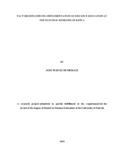| dc.description.abstract | Museums have for a long time served as educational centers in different regions across the
world. However, dynamic changes in the environment have presented lots of challenges with
regard to Museums education and its relevance to its unique clientele. The purpose of this study
was therefore to establish the factors that affect implementation of distance education at the
National museums of Kenya. The objectives of the research work was to determine how
instructional factors; institutional, technological and teachers factors and expertise factors
influence the implementation of distance education at the National Museums of Kenya. This
study utilized descriptive cross sectional study design in which quantitative and qualitative data
was collected and integrated in the explanation of the on the whole results. The target population
was 600 employees working in National Museums of Kenya education and research areas,
Information Technology section, public programs and cultural heritage departments within the
institutional headquarters. Stratified random sampling was applied to collect the required data.
The data was collected using structured questionnaires and key informants interviews guides
tested for validity and reliability. Hence findings reveal that National Museums of Kenya
teachers need training in distance teaching and distance instruction fits within the institution
goals and mission. The findings of this study will help decision makers and Museums
educational officers to package distance educational materials in a way that is expected by end
users and hence have more educational impact to the wider audience. The findings will go a long
way in addressing issues that affect distance education hence making it more accessible to the
marginalized groups. Distance Education is an effective strategy of reaching wider coverage of
employees who are geographically scattered across diverse regions but National Museums of
Kenya should also target on other interested learners. In conclusion The National Museums of
Kenya policy on distance education should be developed to suit the learner’s needs and desires
and the content should be responsive to the diverse cultural backgrounds. Availability of
professional distance education personnel, effective Internet and computers are primary
incentives to successful implementation of Distance learning at the NMK. The study
recommends partnership between NMK and the likeminded organizations’ as well as involves
stakeholders for feedback, monitoring and evaluation. | en_US |

